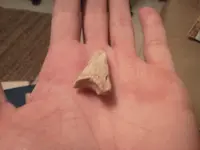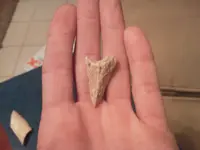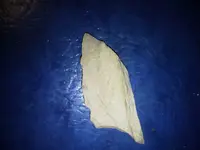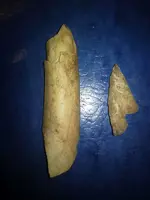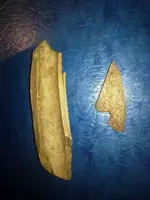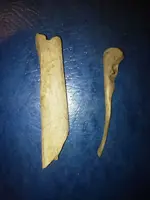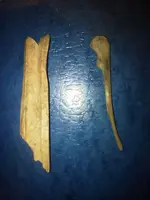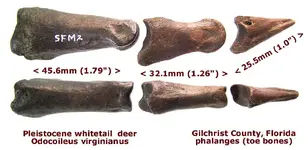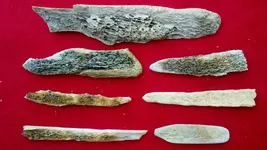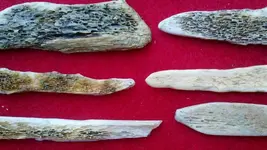You are using an out of date browser. It may not display this or other websites correctly.
You should upgrade or use an alternative browser.
You should upgrade or use an alternative browser.
need help with bone info
- Thread starter rivernomad44
- Start date
T Witko
Sr. Member
- Joined
- Jul 22, 2010
- Messages
- 431
- Reaction score
- 727
- Golden Thread
- 0
- Location
- North Dakota
- Primary Interest:
- Other
Unless there's some sign of use or wear the doesn't show in the photos, you have just some bones. Although it does look like some were broken/split for the marrow.
Harry Pristis
Bronze Member
- Joined
- Feb 5, 2009
- Messages
- 2,353
- Reaction score
- 1,294
- Golden Thread
- 0
- Location
- Northcentral Florida
Unless there's some sign of use or wear the doesn't show in the photos, you have just some bones. Although it does look like some were broken/split for the marrow.
I agree with 'T Witko' . . . unaltered bones.
One is a deer ungual.
NC field hunter
Silver Member
Harry Pristis said:I agree with 'T Witko' . . . unaltered bones.
One is a deer ungual. <img src="http://www.treasurenet.com/forums/attachment.php?attachmentid=666475"/> .
The middle bone on your bottom row is like one that I have held on to. Mine is still white in color. Does that mean that the bone I have is not fossilized, and more than likely I have road kill in a box? If so, she has got to go!
rivernomad44
Full Member
- #5
Thread Owner
cool thank you thats what i figured but worth asking
GatorBoy
Gold Member
- Joined
- May 28, 2012
- Messages
- 14,716
- Reaction score
- 6,156
- Golden Thread
- 0
- Primary Interest:
- All Treasure Hunting
First..none of them are fossilized and also I have a lot of pieces that have what appears to be a ground and polished edge to make a point.I find ALOT of bone in some of my sites..enough to see when something has been altered as compared to not. I belive some of them were used for decorating pottery then tossed.that's not going to show much use wear.also too many shaped alike to dismiss.
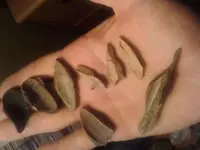

GatorBoy
Gold Member
- Joined
- May 28, 2012
- Messages
- 14,716
- Reaction score
- 6,156
- Golden Thread
- 0
- Primary Interest:
- All Treasure Hunting
This might sound like a silly question..but.. couldn't you just break off the ends and push something through to extract the marrow? And wouldn't splitting leave a splintered edge?..unless scored with a graver Which to me seems more like it would be done to make tools.
Last edited:
rivernomad44
Full Member
- #8
Thread Owner
how can u tell if there fossilized? and do they 100% have to be? jw thanks for all the info
GatorBoy
Gold Member
- Joined
- May 28, 2012
- Messages
- 14,716
- Reaction score
- 6,156
- Golden Thread
- 0
- Primary Interest:
- All Treasure Hunting
No..they shouldn't be...they could be mineralized which would solidify them. Most likely they are sub-fossil. I don't feel like defining fossil right now but what you have there looks like preserved bone from a low oxygen and or low p.h. enviornment like midden soil or mud. That is the norm. For bone artifacts in my area. Here is a bone blade handle I found about a week ago
The site is mostly middle archaic
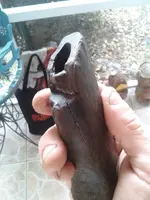
The site is mostly middle archaic

Last edited:
tomclark
Bronze Member
- Joined
- Dec 18, 2006
- Messages
- 1,177
- Reaction score
- 1,641
- Golden Thread
- 0
- Location
- Tampa Bay, FL
- Detector(s) used
- ShadowX2, TEJON, Eyes, Pony Shovel
- Primary Interest:
- Other
They ate the marrow and that's easy to get at, as GatorBoy said. They also broke down and boiled smaller fragments of bone to render the grease out of the bone itself. Several hours of boiling and skimming off the grease would leave a lot of small bone fragments and would also soften the bone pieces up. It is my opinion that without definitive work showing on small pieces of bone, they are just food refuse. But anything can be used as a momentary tool and show little or no work. Work on bone fragments are cuts, abradings, even chips. If you are smashing bone to boil for grease there will be a lot of very similar looking fragments. Bone is so easy to work, compared to shell or stone, you'll see the work unless it's one of those expedient tools.














T Witko
Sr. Member
- Joined
- Jul 22, 2010
- Messages
- 431
- Reaction score
- 727
- Golden Thread
- 0
- Location
- North Dakota
- Primary Interest:
- Other
They ate the marrow and that's easy to get at, as GatorBoy said. They also broke down and boiled smaller fragments of bone to render the grease out of the bone itself. Several hours of boiling and skimming off the grease would leave a lot of small bone fragments and would also soften the bone pieces up. It is my opinion that without definitive work showing on small pieces of bone, they are just food refuse. But anything can be used as a momentary tool and show little or no work. Work on bone fragments are cuts, abradings, even chips. If you are smashing bone to boil for grease there will be a lot of very similar looking fragments. Bone is so easy to work, compared to shell or stone, you'll see the work unless it's one of those expedient tools.







Thanks tomclark, very good information.
Here are a few more examples - split/broken, not used, might have been used (the 2 biggest pieces), and definitely used. I think some may have been used as an "expedient" then discarded. It may also have been kept and used because there was something "right" about it, whether was shape, size, type or probably most important, the density or strength of the bone.
Of course many were specifically made also.
http://www.treasurenet.com/forums/a...142-thanks-doing-some-plowing-larson1951.html
Attachments
Last edited:
Harry Pristis
Bronze Member
- Joined
- Feb 5, 2009
- Messages
- 2,353
- Reaction score
- 1,294
- Golden Thread
- 0
- Location
- Northcentral Florida
The middle bone on your bottom row is like one that I have held on to. Mine is still white in color. Does that mean that the bone I have is not fossilized, and more than likely I have road kill in a box? If so, she has got to go!
"Fossilized" is a near meaningless term. The term is often substituted for "mineralized" in describing a bone or tooth. But, fossilized doesn't always equate to mineralized because many fossils are not impregnated or replaced by minerals.
Bone is primarily composed of hydroxyapatite and collagen. Hydroxyapatite is an inorganic compound of calcium, phosphate, and hydroxide which is organized in a crystal latticework that gives bone (and teeth) structural rigidity. It preserves well as a fossil under some conditions.
Collagen is a fiberous protein that serves as connective tissue in bones and muscles. It does not preserve well in a fossil. As collagen decomposes, it may be replaced in the hydroxyapatite latticework by minerals from the depositional environment (e.g. silica dioxide dissolved in groundwater).
Bone reinforced with exogenous minerals is said to be mineralized.
A 'burn test' or 'match test' will usually indicate whether there is collagen remaining in a bone -- scorched collagen has an awful smell. Teeth - dentin and enamel - contain hydroxyapatite, but don't contain collagen, so the 'burn test' on a tooth would be a waste of time.
NC field hunter
Silver Member
Harry Pristis said:"Fossilized" is a near meaningless term. The term is often substituted for "mineralized" in describing a bone or tooth. But, fossilized doesn't always equate to mineralized because many fossils are not impregnated or replaced by minerals.
Bone is primarily composed of hydroxyapatite and collagen. Hydroxyapatite is an inorganic compound of calcium, phosphate, and hydroxide which is organized in a crystal latticework that gives bone (and teeth) structural rigidity. It preserves well as a fossil under some conditions.
Collagen is a fiberous protein that serves as connective tissue in bones and muscles. It does not preserve well in a fossil. As collagen decomposes, it may be replaced in the hydroxyapatite latticework by minerals from the depositional environment (e.g. silica dioxide dissolved in groundwater).
Bone reinforced with exogenous minerals is said to be mineralized.
A 'burn test' or 'match test' will usually indicate whether there is collagen remaining in a bone -- scorched collagen has an awful smell. Teeth - dentin and enamel - contain hydroxyapatite, but don't contain collagen, so the 'burn test' on a tooth would be a waste of time.
Man Harry! You know your anatomy. I see now that you are a reliable info source on bone, shell, and antler. Do you mind telling me what makes you think my pendant is turtle shell? Sorry if I got off on the wrong foot with you. I'll post the pic again incase you have forgotten it. Thanks!!
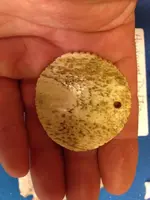
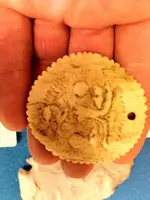
NC field hunter
Silver Member
I do know that box turtles were the primary food source around here. A real archeologist told me this, and it makes sense. Turtles are a pretty easy catch.
Harry Pristis
Bronze Member
- Joined
- Feb 5, 2009
- Messages
- 2,353
- Reaction score
- 1,294
- Golden Thread
- 0
- Location
- Northcentral Florida
Man Harry! You know your anatomy. I see now that you are a reliable info source on bone, shell, and antler. Do you mind telling me what makes you think my pendant is turtle shell? Sorry if I got off on the wrong foot with you. I'll post the pic again incase you have forgotten it. Thanks!!
View attachment 667226
After following the other thread, and after doing some shopping on the www, I believe that your pendant is not turtle bone.
I think your pendant is probably water buffalo bone carved in Indonesia in 1994 (+/- ten years). The face is distinctly oriental, and that's a common carving medium in SE Asia.
NC field hunter
Silver Member
Harry Pristis said:After following the other thread, and after doing some shopping on the www, I believe that your pendant is not turtle bone.
I think your pendant is probably water buffalo bone carved in Indonesia in 1994 (+/- ten years). The face is distinctly oriental, and that's a common carving medium in SE Asia.
Really man, you are you are just F'n with me, right. Indonesian water buffalo ? I'm going to do a little research, and if I can't find any thing about...LOL. Indonesian water buffalo, I won't bother you any more. I already know the date is wrong. I know when I found it
Harry Pristis
Bronze Member
- Joined
- Feb 5, 2009
- Messages
- 2,353
- Reaction score
- 1,294
- Golden Thread
- 0
- Location
- Northcentral Florida
I do know that box turtles were the primary food source around here. A real archeologist told me this, and it makes sense. Turtles are a pretty easy catch.
THE primary food source?? That sounds dubious. What I have read (though I don't remember where) is that it is risky to eat box turtle because of their fondness for fungi, including the poisonous varieties. The toxins may be present in the box turtle's flesh. Native Americans did enjoy softshell turtles, though.
NC field hunter
Silver Member
Harry Pristis said:THE primary food source?? That sounds dubious. What I have read (though I don't remember where) is that it is risky to eat box turtle because of their fondness for fungi, including the poisonous varieties. The toxins may be present in the box turtle's flesh. Native Americans did enjoy softshell turtles, though.
I'll make a call this weekend and find out for sure. I'm pretty sure he said box turtle. The archeologist friend of mine worked in Tennessee for most of his career. Just a thought of mine, I know that certain fungi live in certain places and not others. You see what I'm aiming at. About that pendant, I can see that your thought has relevance. Many of the Indonesian sun images share similar facial features as that of mine. Indonesian water buffalo threw me for a loop. Thank you for not misleading me. I thought you were doing me like Ticm did that guy.
Similar threads
- Suggestion
- Replies
- 6
- Views
- 319
- Replies
- 31
- Views
- 1K
- Replies
- 2
- Views
- 700
Users who are viewing this thread
Total: 1 (members: 0, guests: 1)


